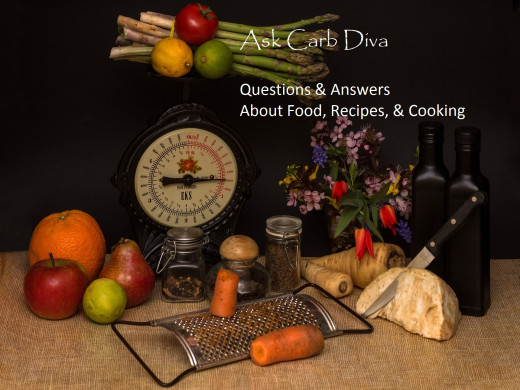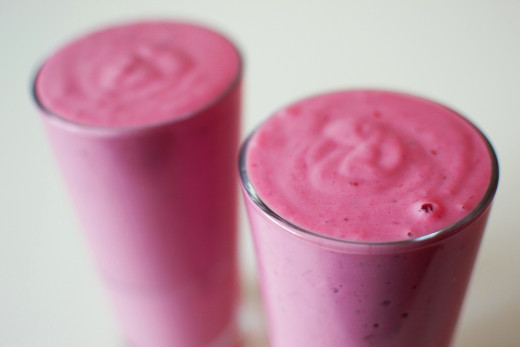Ask Carb Diva: Questions & Answers About Food, Recipes, & Cooking, #138

I Guess It Pays to Advertise
Last week I was lamenting that I had not received any questions. Poor pitiful little me. Well, hallelujah, the flood gates opened. (Are you familiar with the expression "be careful what you pray for"?)
Here's a sampling of what I got. I'm still working on a few that will be published next week.
All About Smoothies
My dear friend Bill Holland responded to last week's lack of questions:
"No questions? A sacrilege I say. How about a couple of smoothie recipes for us all as summer approaches and berries ripen? Happy Monday my friend...and where did the smoothie originate, if you have the time."
Bill, my dad used to say "I've got more time than money." For you, of course, I'll do this. First, on the slight chance that someone on the planet does not know what a smoothie is, I'll do my best to explain. Next, a bit of a history lesson, and then several recipes—at least one with berries, OK?

Smoothies are drinkable meals—a combination of pureed fruits and/or vegetables, a liquid (often dairy or plant-based dairy substitute), and ice. Although ice cream and fruit combinations have been around for at least a century, I think we can be confident in saying that the actual smoothie is a 20th-century invention, although exactly which part of the century is still up for debate.
Some think that the smoothie began when Norman W. Walker invented the juicer in 1936. Walker was a pioneer in the concept of “juicing (pulverizing raw fruits and vegetables to make a drinkable juice) and was a proponent of the raw diet. The “guru” did not find many followers at that time, but in the 1970s there was a shift from the “meat and potatoes” culture of the previous generations to a more healthy diet. Steve Kuhnau opened a health-food store in 1973 and expanded that concept to a franchise, Smoothie King, in 1987. It didn’t take long for other competitors to introduce their own ideas of the perfect smoothie; Jamba Juice began in 1990 and by the end of the 20th-century countless juice bars, carts, and kiosks sprang up throughout the United States.
Bill, you wanted recipes? Here are a few that you might enjoy (I promise, no spinach was harmed in the making of these smoothies).
Mixed Berry Smoothie - One cup each of milk, mixed berries (your choice), and ice are combined with a 5.3-ounce container of plain or vanilla Greek yogurt.
Peach Raspberry Smoothie - 6 ounces of plain yogurt, 1 medium sliced peach, 1/2 cup raspberries, and 1/4 teaspoon vanilla extract.
Lemon Smoothie (sunshine in a bottle) - yogurt, ice, fresh lemon juice, honey, fresh ginger, and a pinch of turmeric.
Peanut Butter-Banana Smoothie - Obviously peanut butter and banana plus water or milk, flax seeds, and vanilla.
Smoking Foods Without a Smoker
I know I can always rely on Eric Dierker to come up with a really good question.
"Dear Ms. Diva, I have a problem. My son and I really like smoked foods. Fish being our favorite. But, But and more but as Gabe would say. Store-bought is way too expensive and usually way too salty. We do not own a smoker. What should we do to make our own? Let's go with a grill, but then my oven too. Watch out for the fire alarm!"
Eric, some of my best memories of my inlaw's summer place at Charlotte Lake, B.C. is the trout we would catch and then finish off in the smoker. It wasn't the kind you buy at Home Depot—it was an honest-to-goodness smoker built into the hillside, stoked with local slivers of birch. The fish, brined in salt and brown sugar, was moist, succulent, sweet-salty. Absolute Heaven!
Some People Actually Smoke Foods In Their Kitchen
So, how can we replicate that at home? If you don't have a smoker (and you and I don't) what can you do? I found a recipe on YouTube that looks simple enough. Your fish will have a delicate smoke flavor, and notice that he didn't brine it or douse with salt. My only concern is that he must have disconnected the smoke detector in his kitchen.
This next two don't first set the wood chips ablaze, but I still see wisps of smoke escaping. I know the noise of the smoke detector in my house would be deafening.
This last video uses liquid smoke instead of relying on actual smoking chips. Look for it in the condiment aisle of your grocery store or near the barbecue sauces. It will be a small bottle, probably on the top shelf.
Have You Heard of Liquid Smoke?
Here's a link from one of the companies that manufacture liquid smoke with more recipes than I can list.
And, believe it or not, I have a clipping from the March 1987 issue of Sunset magazine. It's not available online, so I'll share the information here.
"Pour 3 tablespoons liquid smoke into a 5- to 6-quart pan. Set a perforated or wire rack in the pan. Arrange food (select from chart, following) in a single layer on rack and tightly cover the pan. Bake in a 350°F oven until food tests done (see chart). Serve hot, tepid, or chilled. If made ahead, let cool, cover, and chill up to 2 days. Makes 2 to 4 servings."
Foods to Try
| Maximum amount or size
| How do you know when they're done?
|
|---|---|---|
Whole chicken breasts (1 lb each), boned, skinned, and cut in half
| 4 half-breasts
| White in center (cut to test), 20 to 25 minutes
|
Chicken legs (thigh with drumstick)
| 4 legs (1 1/2 to 2 lb total)
| No longer pink at thigh bone (cut to test), 40 to 50 minutes
|
Whole broiler-fryer chicken
| 3 to 3 1/2 lb
| No longer pink at thigh bone (cut to test), 1 1/4 to 1 1/2 hours
|
Pork tenderloin
| 1 to 2 lb total
| Meat thermometer inserted in thickest part reads 160 and meat is no longer pink in center (cut to test), 35 to 45 minutes
|
Pork chops
| 4, each cut 1 inch thick
| No longer pink in center (cut to test), 25 to 30 minutes
|
Trout, whole
| 10 to 11 in. long each (about 1 lb total)
| Fish is opaque in center of thickest part (cut to test), about 20 minutes
|
Salmon, steak or fillet (skin removed)
| 1-inch thick steaks; 3/4 lb fillet
| Fish is opaque in center of thickest part (cut to test), 15 to 25 minutes
|
Thin-skinned potatoes, scrubbed and cut in half lengthwise
| 3 or 4 large (1 1/2 to 2 lb total)
| Tender when pierced, about 45 minutes.
|
But If You Really Want to Use Real Smoke
You can use your outdoor grill. The folks at Webber gas grill have a great internet article on how to get that low-and-slow smokey flavor without a smoker.
Can I "Make" Heavy Cream from Light Cream and Will It Whip?
"I have a question for you. I read that you can make heavy cream from light cream by adding melted butter. Would I be able to whip that and also, will it work with UHT cream that is 17% fat?"
Mary (Blond Logic) I really had to scramble to find the answer to this one. It is possible to "create" whipping (heavy) cream from light cream and it will work perfectly in cooking, but if you want to actually whip it, you might be disappointed. Yes, adding butter will work, but you need to freeze the mixture first and then beat it like crazy. You can also create a faux whipping cream by adding unflavored gelatin. Again, it won't keep its peaks forever. Here's the link to a cook who does a great job of explaining the differences between various kinds of "cream" and how to whip them.
And then, there's UHT cream. {{Sigh}}. I wish I had good news to offer but . . . UHT means ultra-high temperature” which alters the molecular structure. Look at the list of ingredients—you'll see that there are added thickeners and stabilizers to give it the same luxurious appearance and mouth feel of "real" whipping cream, but they don't make it "whippable."
However, if you can find a can of chickpeas, you can make faux whipped cream with aquafaba. Here's a link to explain how.
We're Organized
Did you know that there is a Table of Contents for this series? I have created an article that provides a detailed listing of each question I've received. It's broken down by category, and within each category, the questions are listed alphabetically. Each question is actually a hotlink back to the original post.
Here's a link to that Table of Contents.
I have also cataloged all of my personal recipes that I have shared with you in this weekly Q&A series and in all of my other articles as well. The link to that Index is here. There are hotlinks to each recipe and this will be updated as new recipes are shared.

And, So . . .
Let's do this again next week. If you have questions about foods, cooking techniques, or nutrition you can ask them here. If you are in search of an old recipe or need ideas on how to improve an existing one I can help you. If you want to learn more, let's do it together. Present your questions, your ideas, your comments below. Or, you can write to me personally at this email address: lindalum52@gmail.com.
And, I promise that there will always be at least one photo of a kitty in every Monday post.








